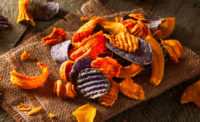The bars category features a multitude of product types that offer snacking opportunities throughout the day. Whether a granola, nutritional, sports nutrition, breakfast, or some other type of bar, more people are opting for the convenience they offer. As noted in our 2022 State of the Industry coverage, bar sales are up across the board—and in some cases, with significant gains over the past year (see “State of the Industry 2022: Snack bars rise in popularity as consumers return to ‘every day’ lives”).
Fruit ingredients are a natural fit for bar formulations, offering contributions like flavor, functionality, and overall label appeal. In order to learn more about this key aspects of bar product development, we reached out to Jeannie Swedberg, director of customer development and marketing, Tree Top Ingredients, Selah, WA.
Douglas J. Peckenpaugh: What are the top trends you are seeing in the bar category?
Jeannie Swedberg: The health and wellness trend is impacting the bar category much like it is the overall food and beverage market. In particular, the desire to eat more mindfully, such as choosing immune-enhancing, energy-boosting, and mood boosting products along with other ones with functional benefits has gained a lot of traction in the bar market. The pandemic led people to think proactively about maintaining their health—both physical and mental—by the foods they eat. According to Mintel, 93% of American adults are making some effort to eat healthfully.
Bars are a convenient way to deliver health-promoting ingredients. We’re seeing this not only in clean label claims for ingredients but also in functional ingredient claims for stress and anxiety relief, immune support, digestive support, and more.
People are moving away from the concept of dieting to lose weight and toward following a diet pattern for health maintenance. So, we’re seeing fewer bars positioned as weight loss aids and more low-carb, keto, gluten-free, plant-based, anti-inflammatory, etc., types.
Interest remains strong in bars with a minimum of easily understood ingredients. The label declarations of purity are longer than the actual ingredients list on some bars, i.e., organic, kosher, allergen-free, non-GMO, no added sugar, vegan, halal, no artificial colors or flavors, no high-fructose corn syrup, and the list goes on.
Now that people are getting back to “normal,” bars are again filling the need for on-the-go snacking and mini meals. This has people seeking nutrient dense bars that will both fortify and satisfy.
DJP: What roles do fruit ingredients play in bar formulations?
JS: As a single ingredient, fruit can provide multiple functions in a bar. Fruit ingredients add flavor and color, act as binders, contribute sweetness, and add fiber. They are also nutrient-dense. The nutritional makeup of each, of course, varies by fruit type and format. For example, dark-colored berries often contain lots of antioxidants.
Fruit can be used to deliver sweetness in bar formulations, thereby eliminating the need for added sweeteners.
And you can’t ignore that just having fruit on an ingredient list is beneficial. Fruit has a natural health halo. It’s well-liked, nutritionally appreciated, and universally understood on ingredient lists.
DJP: How can different combinations of fruit ingredients bring differentiation to bar products?
JS: Combining familiar and exotic fruit ingredients – people are more likely to try something new if you pair it with something familiar. Local fruit or varietals offer another way to differentiate and combine fruit types to pique consumer interest.
Combine fruits to achieve different levels of nutrient density—vitamins, fiber, etc.—or functional benefits, such as immune enhancement or digestive support.
Fruit can be combined in ways that appeal to different eating occasions or demographics. There are kid-friendly fruits, such as apples, strawberries, blueberries, and peaches. Then you might have a sophisticated combination of tart apple and boysenberry, or apricot and mango, that appeals more to adult consumers.





